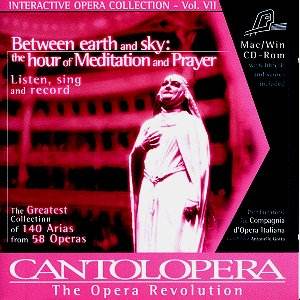Being
an ‘elderly’ dog is, in the context of reviewing opera’ a mixed
blessing. The plus is the fact that I draw on fifty years of listening
to, and seeing opera; from the days of Cetra’s ‘Green Label’ LPs,
when staged performances related to what the composer wrote rather
than deconstructed (a.k.a. destroyed) producer interpretations,
to the challenge of the current CD-ROM under review. The latter
required me to learn quite a few new tricks! First I had to work
out if my PC met the required spec for MacOS or Windows 95/98/2000
and which required a minimum of 16 MB RAM available for Cantalopera
and 20 MB free space on the hard disc. These and other requirements
are specified in more detail on the inside of the very basic accompanying
leaflet (and at www.cmc.cantolopera.com).
Being
a long time ‘empty nester’ and therefore not having any resident
adolescent, or younger, experts to assist in getting loaded and
started, had its moments of frustration/exasperation, but once
on board, as it were, fascination was followed by addiction so
that I now live in an opera lovers nirvana (but no Wagner on this
disc) of an opera addict. I’ve given up bed as I work my way round
the hours of this disc which contains: ‘a four tracks Digital
Recording Studio’; ‘over three hours of Hi-Fi stereo music’; ‘100
pages of information and documents, librettos and scores’; ‘300
pictures, audio and video interviews, columns, a glossary;’
That
brief summary gives only an introduction to the treasures present
on each disc, not to mention the self-indulgences allowed for!
For example, under the heading ‘ColuMns’ (sic) there are a number
of sub headings as follows: ‘Good Singing’, which in this
volume deals with the baritone voice. A spoken and visual narrative
analyses the characteristics of the vocal register and relates
that to named examples giving a critique of each. Thus the names
of Battistini, Ruffo, Amato, Bechi, Gobbi, Cappuccilli, Bruson,
and Zancanaro, amongst others are considered. I personally didn’t
always agree with the comments but it was the exception when I
didn’t. ‘Era’ on this volume dealt with Verdi related to
the belcantoists that precede him and the verismo composers who
followed. ‘Interviews’. Brief interviews included a music
critic and two famous singers, the soprano Rosana Carteri and
the baritone Rolando Panerai. ‘Opinions’. Opinions on seven
famous singers such as Bergonzi, del Monaco is given with reference
to their vocal characteristics, career and repertoire. ‘Vocality’.
This heading denotes a great treasure trove. Each vocal register
can be selected and heard, and if you have a microphone and your
PC the hardware, then you can determine, with guidance and graphs,
your personal vocal register; and don’t be arrogant and assume
you already know!
The
arias listed in the header are all there to be heard alone, together
with the libretto and music and with the possibility for you to
do the singing as the words and music score pass in front of you.
This has nothing to do with ‘karaoke’ or singing in the bathroom,
but has serious as well as fun possibilities.
For
me another treasure was the glossary that goes from ‘Aria’ to
‘Zarzuela’ with definitions of each alongside as one clicks. These
definitions are not trite either. Aria is divided into 14 sub-divisions
such as agginata, buffa through bravura, to di portamento and
more. There are biographies for listening, Callas, Ponselle and
others. This one disc is a veritable treasure trove for the opera
lover and it is only one of ten volumes, with the others covering
different facets and voice types. Buy one of the series, if it
appeals then get the rest and you will have an operatic diamond
mine at your fingertips.
Robert
J Farr

